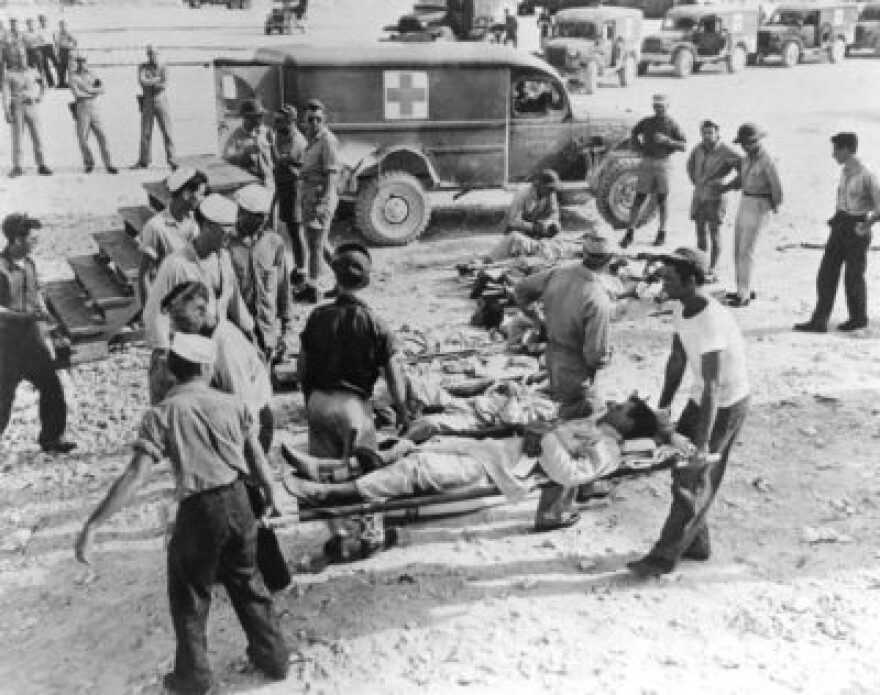It’s one of the most iconic scenes in the movie Jaws. The shark hunter named Quint describes what it's like being a crew member on a ship that was torpedoed and sank, becoming one of the greatest disasters in U.S. naval history. Hundreds of crew members died in the ocean from shark attacks.
"Do you know anything about a shark? He's got lifeless eyes," said Quint in the film. "Black eyes, like a doll's eyes. When he comes at you, he doesn't seem to be living until he bites you. Then, those black eyes roll over wide, and then, you hear that terrible high-pitched screaming. The ocean turns red. In spite of all the pounding and hollering, they all come in and rip you to pieces."
While Robert Shaw was an actor, the story he was telling was a true one. July 30 marks the 80th anniversary of the sinking of the USS Indianapolis.
In the closing days of World War II, the cruiser was sent on a secret mission from the San Francisco Bay Area to the South Pacific. Its payload was the atomic bomb, which was dropped on Hiroshima. After delivering the bomb to an island airbase, the Indianapolis was headed through the South Pacific by itself to join a fleet when disaster struck.

"They got orders to go on and join the rest of the fleet over in Leyte to prepare for the invasion of Japan," said Jane Gwinn Goodall. The Ventura woman is a historian of the disaster, but it was personal for her because her father played a key role in rescuing the survivors.
"It's now 27 hours after they delivered the atomic bomb, and they are on their way to Leyte, in the deepest part of the Philippine Sea," said Goodall. "Right about midnight, as the calendar turned to July 30th, they were hit by two torpedoes from a Japanese submarine. The first torpedo took out the communications of the ship. The second created a lot of explosions."
Because the ship's communication area was knocked out, no distress signal was sent, and it sank in minutes.
There were 1,195 crew members on the Indianapolis. About 300 went down with the cruiser, and about 900 made it into the water. Some were injured, many were covered with oil, and there were only a handful of life rafts. By the next day, the sharks found them.
"They would do what they could to kick. They would hear screams off in the night. They would reach over to wake their buddy up, and half of them were missing," said Goodall.
No one reported the ship missing. They spent five nights and four days in the water. Finally, on August 2, a plane piloted by Chuck Gwinn, Jane Gwinn Goodall’s father, spotted some survivors.
"They were on an antisubmarine patrol when he spotted this oil slick," said Goodall. The crew didn't see it at first. "He said, 'Look down, you'll see'. The oil slick is going on for miles and miles, so he goes down even lower, and now he starts to see these little black balls on the top of the water. Those little black balls were the men covered in oil."
Rescue teams came by air and by ship. But, more than 500 men had died in the water from their injuries, from exposure, and from shark attacks.

As one of the rescuers, Gwynn was invited to crew reunions over the decades. His daughter, Jane Gwinn Goodall, became involved in the reunions and has been a part of them for more than 50 years. The Ventura woman is in Indianapolis right now, where the 80th anniversary commemoration of the event is underway.
She’s written a book about a little-known aspect of the disaster. It’s called Heroes in the Shadows. It’s the story of the 28 African-American sailors serving on the ship when it sank. None of them survived.
Goodall says that while the movie Jaws got some of the statistics about the disaster wrong, survivors were grateful for the scene because it helped bring attention to the mostly forgotten part of history.
Out of a crew of 1,195 men, 316 survived the ordeal. Only one is still alive today: Harold Bray, 98, who lives in the San Francisco Bay Area. Because of his age, he’s unable to make the trip, but he’ll be celebrated during the commemoration underway this week in Indianapolis.



